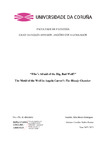Who’s Afraid of the Big, Bad Wolf? The Motif of the Wolf in Angela Carter’s The Bloody Chamber
Title
Who’s Afraid of the Big, Bad Wolf? The Motif of the Wolf in Angela Carter’s The Bloody ChamberAuthor(s)
Directors
Núñez-Puente, CarolinaDate
2023Center/Dept./Entity
Universidade da Coruña. Facultade de FiloloxíaDescription
Traballo fin de grao (UDC.FIL). Inglés: estudios lingüísticos y literarios. Curso 2022/2023Abstract
[Abstract] The object of study of this end-of-degree project is the wolf trilogy of Angela Carter’s
The Bloody Chamber, written in 1979. The aims that I will pursue are two: to analyse the figure
of the wolf in this work, and, by doing this, to demonstrate how the feminist rewriting of fairy
tales allows Carter to focus on the aspects which remain hidden in the original versions. I will
also examine aspects related to female sexuality, patriarchal conventions, identity, otherness
and binary oppositions as male/female or human/animal. All of these concepts are relevant in
the fields of Gender and Feminist Studies.
The methodology that I followed consisted, first of all, of an in-depth reading of Carter’s
The Bloody Chamber. After doing this, the presence of the wolf in three of the stories made me
consider the possibility of studying the multiple interpretations that the figure of this animal
represents in this work. As a result, before beginning my analysis, I needed to obtain
information about basic aspects; therefore, I consulted different books and some articles that I
found in JSTOR or Google Scholar. Consequently, I read about wolves’ relevance in culture
and literature—e.g. Dundes, Mitts-Smith—, about the poetics of feminist rewriting of fairy
tales—e.g. Bacchilega, Sellers, Warner, Zipes—and, lastly, analysis of Carter’s stories—e.g.
Al-Kassasbeh, Ekmekçi, Lau. Finally, the use of dictionaries, such as The American Heritage
Dictionary of English Language or Cambridge English Dictionary was also useful.
The structure of this undergraduate thesis consists of two main parts, whereas the first
one includes two sections, the second one contains three. The first part examines the basic
elements that need to be explained before the analysis of Carter’s tales: primarily, the relevance
of the figure of the wolf in culture, focusing on its presence in “Little Red Riding Hood,” owing
to Carter’s interest in this story when writing her wolf trilogy. The second section studies the
literary tendency in which the author is considered a pioneer and, thus, a referent: the feminist rewriting of fairy tales. These renewed stories defy gender roles and unmask the hidden
elements of the original versions.
The second part of this dissertation focuses on the analysis of Carter’s wolf trilogy: “The
Werewolf,” “The Company of Wolves” and “Wolf-Alice.” Subsequently, this section includes
three chapters, as I study each story individually. This paper finalizes with a conclusion, in
which I summarize the main ideas and I ratify my aims, demonstrating that they have been met.
The pages that follow will examine the motif of the wolf in Carter’s The Bloody Chamber, a
work in which the readers can find the multi-layered wolves that inhabit the author’s universe:
from a grandmother who is, in fact, an evil werewolf, through the attractive wolf who acts as a
symbol of females’ sexual liberation, and, finally, Wolf-Alice, the hybrid wolf-girl who bravely
embraces her “otherness.”
Keywords
Carter, Angela
Wolf
Fairy tales
Female sexuality
Feminism
Otherness
Wolf
Fairy tales
Female sexuality
Feminism
Otherness
Rights
Os titulares dos dereitos de propiedade intelectual autorizan a visualización do contido deste traballo a través de Internet, así como a súa reproducción, gravación en soporte informático ou impresión para o seu uso privado e/ou con fins de estudo e de investigación. En nengún caso se permite o uso lucrativo deste documento. Estos dereitos afectan tanto ó resumo do traballo como o seu contido Los titulares de los derechos de propiedad intelectual autorizan la visualización del contenido de este trabajo a través de Internet, así como su repoducción, grabación en soporte informático o impresión para su uso privado o con fines de investigación. En ningún caso se permite el uso lucrativo de este documento. Estos derechos afectan tanto al resumen del trabajo como a su contenido






